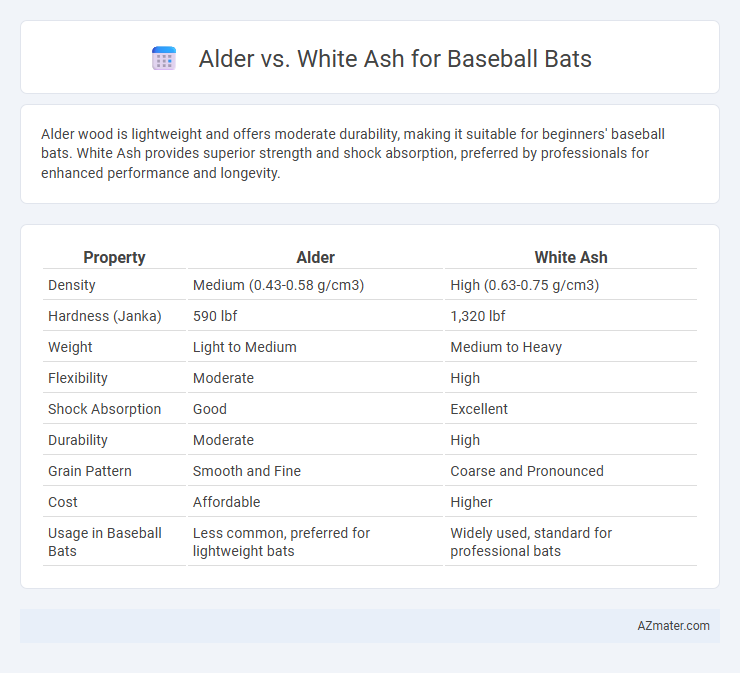Alder wood is lightweight and offers moderate durability, making it suitable for beginners' baseball bats. White Ash provides superior strength and shock absorption, preferred by professionals for enhanced performance and longevity.
Table of Comparison
| Property | Alder | White Ash |
|---|---|---|
| Density | Medium (0.43-0.58 g/cm3) | High (0.63-0.75 g/cm3) |
| Hardness (Janka) | 590 lbf | 1,320 lbf |
| Weight | Light to Medium | Medium to Heavy |
| Flexibility | Moderate | High |
| Shock Absorption | Good | Excellent |
| Durability | Moderate | High |
| Grain Pattern | Smooth and Fine | Coarse and Pronounced |
| Cost | Affordable | Higher |
| Usage in Baseball Bats | Less common, preferred for lightweight bats | Widely used, standard for professional bats |
Introduction to Baseball Bat Woods
Alder and white ash are popular woods used in the crafting of baseball bats due to their distinct properties. Alder offers lightweight characteristics and a softer feel, ideal for players seeking better bat control and quicker swing speeds. White ash provides a combination of strength and flexibility, delivering powerful hits with greater durability and resistance to cracking, making it a preferred choice for professional-level play.
Overview: Alder and White Ash
Alder wood is known for its lighter weight and softer feel, offering increased bat speed and reduced vibration, making it ideal for players seeking better control and less sting during swings. White Ash is prized for its superior strength, durability, and classic grain patterns, providing enhanced power and resistance to impact, favored by players who prioritize bat performance and longevity. Both woods offer distinct advantages; Alder excels in lightweight flexibility, while White Ash delivers robust strength suited for intense gameplay.
Grain Structure Comparison
Alder wood presents a straight, fine grain structure that offers a consistent hitting surface and moderate hardness, ideal for players seeking a balanced bat with good pop and durability. White Ash features a more pronounced, open grain with interlocked fibers, providing excellent shock absorption and flexibility, resulting in powerful hits and a classic feel favored by many professionals. The tighter grain of Alder results in less vibration upon impact, while White Ash's distinctive grain pattern delivers a combination of strength and resilience, influencing bat performance and player comfort.
Weight and Balance Differences
Alder baseball bats are generally lighter than white ash bats, offering improved swing speed and maneuverability for players seeking quick bat control. White ash, known for its denser grain and durability, tends to weigh more, providing a solid, balanced feel that enhances power during contact. The weight distribution in alder bats often favors a more balanced or slightly end-loaded design, while white ash bats typically feature a consistent weight balance that appeals to players prioritizing a blend of strength and precision.
Durability and Lifespan
White Ash baseball bats offer superior durability and a longer lifespan compared to Alder, thanks to their dense grain structure and shock-absorbing qualities. White Ash can withstand frequent impacts and resists cracking better, making it ideal for players seeking long-term performance. Alder, while lighter and softer, tends to wear out faster and is more prone to denting, reducing its overall lifespan.
Flexibility and Performance
Alder wood baseball bats offer excellent flexibility due to their lightweight and softer grain, making them ideal for players seeking better swing control and increased bat speed. White ash bats are known for their superior performance with a denser grain structure, providing enhanced durability and powerful ball contact. The balance between flexibility in alder and strength in white ash allows players to choose based on swing style and hitting preferences.
Power and Pop at the Plate
White Ash baseball bats deliver superior power and pop at the plate due to their dense wood structure and higher stiffness, resulting in faster swing speeds and more ball exit velocity. Alder bats, while lighter and more affordable, absorb more vibrations, which can reduce the effective energy transfer during contact and limit power output. Players seeking maximum pop and impactful hits often prefer White Ash bats for their improved energy return and durability.
Player Preferences and Usage
Alder baseball bats are favored by players seeking lightweight, balanced performance with quick swing speed, making them ideal for contact hitters who value control and precision. White ash bats offer a stiffer feel and greater durability, preferred by power hitters who benefit from the wood's natural flex and increased pop off the barrel. Players aiming for a traditional bat profile often choose white ash for its classic grain structure and moderate weight distribution, enhancing overall performance in competitive play.
Cost and Availability
Alder baseball bats are generally more affordable than white ash bats, making them a popular choice for beginners and budget-conscious players. White ash bats offer greater durability and better grain structure but tend to be pricier and less widely available due to higher demand from professional and advanced players. Both materials can be found at major sports retailers, though alder bats are often easier to locate in entry-level and youth categories.
Choosing the Best Wood for Your Bat
White ash offers superior strength and flexibility, making it the preferred choice for baseball bats that require a balance of power and durability. Alder wood, while lighter and softer, provides excellent swing speed and control, favored by players prioritizing quickness and maneuverability. Selecting between white ash and alder depends on whether you prioritize bat longevity and pop (white ash) or lightweight feel and faster swings (alder).

Infographic: Alder vs White Ash for Baseball Bat
 azmater.com
azmater.com